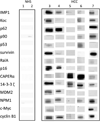Using immunomic approach to enhance tumor-associated autoantibody detection in diagnosis of hepatocellular carcinoma
- PMID: 24667685
- PMCID: PMC4096568
- DOI: 10.1016/j.clim.2014.03.007
Using immunomic approach to enhance tumor-associated autoantibody detection in diagnosis of hepatocellular carcinoma
Abstract
To explore the possibility of using a mini-array of multiple tumor-associated antigens (TAAs) as an approach to the diagnosis of hepatocellular carcinoma (HCC), 14 TAAs were selected to examine autoantibodies in sera from patients with chronic hepatitis, liver cirrhosis and HCC by immunoassays. Antibody frequency to any individual TAA in HCC varied from 6.6% to 21.1%. With the successive addition of TAAs to the panel of TAAs, there was a stepwise increase of positive antibody reactions. The sensitivity and specificity of 14 TAAs for immunodiagnosis of HCC was 69.7% and 83.0%, respectively. This TAA mini-array also identified 43.8% of HCC patients who had normal alpha-fetoprotein (AFP) levels in serum. In summary, this study further supports the hypothesis that a customized TAA array used for detecting anti-TAA autoantibodies can constitute a promising and powerful tool for immunodiagnosis of HCC and may be especially useful in patients with normal AFP levels.
Keywords: Autoantibodies;; Cancer immunodiagnosis;; Hepatocellular carcinoma; Tumor-associated antigens (TAAs);.
Copyright © 2014 Elsevier Inc. All rights reserved.
Conflict of interest statement
The authors have no conflict of interest to disclose.
Figures







References
-
- Bruix J, Sherman M. Management of hepatocellular carcinoma. Hepatology. 2005;42(5):1208–1236. - PubMed
Publication types
MeSH terms
Substances
Grants and funding
LinkOut - more resources
Full Text Sources
Other Literature Sources
Medical
Research Materials

